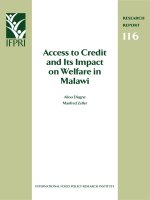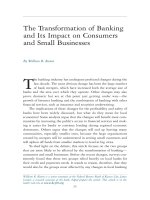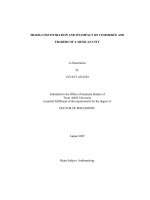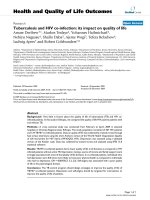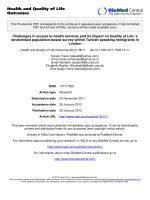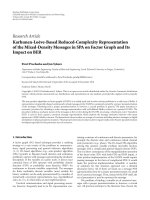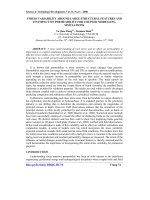America’s Indo-Pacific strategy and its impact on cooperation and development in Asia
Bạn đang xem bản rút gọn của tài liệu. Xem và tải ngay bản đầy đủ của tài liệu tại đây (221.68 KB, 12 trang )
America’s Indo-Pacific Strategy and Its Impact
on Cooperation and Development in Asia
Cu Chi Loi1
1
Vietnam Institute of Americas Studies, Vietnam Academy of Social Sciences.
Email:
Received on 12 March 2019.
Revised on 15 May 2019.
Accepted on 19 July 2019.
Abstract: The Indo-Pacific Strategy is the basic content of the Asian policy of the United States
(US) under the current US administration. The new US strategy emphasises the issue of "freedom"
and "openness" in the relationship between the US and Asian countries as well as in the
relationship among countries in the region. The US advocates a revision of the current imbalanced
and unfair trade between the US and Asian countries, especially its major partners; promotion of
transparent cooperation among countries, and resistance to the threat of big countries in
maintaining maritime freedom and national sovereignty issues in the region. With this strategy,
US-China relations are entering a period of real strategic competition. The tensions between the US
and China have a multidimensional impact on relations among countries in Asia concerning both
economic and security fields.
Keywords: Indo-Pacific, Belt and Road Initiative, the US national security strategy, diamond quadrangle.
Subject classification: International studies
1. Introduction
In recent decades, the world has witnessed a
high dynamism in Asian development.
Previously, the "miraculous" development
of the region had some regional economies,
such as Japan, the Republic of Korea (South
Korea), Singapore, and Taiwan, to become
the world's fastest-growing economies.
Recently, this "miraculous" development
has once again brought some countries into
great powers, namely China and India.
China's recent development was much
40
stronger than that of other economies in the
region when its economic growth rate was
maintained at double digits for many years,
and in the first decade of the 21st century,
the size of China's economy surpassed
those of Germany and Japan and has
become the second-largest economy in the
world after the US.
With improved economic potential, China
is now ambitious to become a superpower
through the realisation of the "Chinese Dream"
and the "great Chinese revival". To become a
country of regional and international influence,
Cu Chi Loi
China needs a strong economy, strong military
forces, and tough foreign policies that
demonstrate national power. It has invested
heavily in defence to modernise its military.
China's military forces have experienced rapid
improvements in power with a range of new
and advanced weapons capable of an enlarged
range of operation. In particular, its naval
forces are being given prioritised resources
and are achieving rapid improvement in
combat capacity, a rapid increase in the
number of submarines and surface ships, as
well as advanced anti-ship missiles capable of
challenging the US Navy in the Western
Pacific region. It is the rapid growth of military
forces in general and the navy and coast guard
in particular that have created significant
advantages for China to increase its potential
in territorial disputes with neighbouring
countries and challenges of freedom of
navigation in the Asia-Pacific region.
China's recent growth and its geopolitical
and geostrategic ambitions are exerting a
strong impact on US-China relations.
Economic and security challenges to the
US in Asia are quite diverse (ranging from
the Democratic People’s Republic of
Korea's weapon programme to terrorist
organisations in Southeast Asia and South
Asia as well as non-conventional security
issues). However, the US government is
increasing priorities to counter challenges
imposed by China. Currently, the US sees
China as a strategic competitor, and China's
growth and ambitions are undermining the
role and interests of the US in this region. In
response to these challenges, in stead of the
previous strategy of "rebalancing to Asia", the
administration of President Donald Trump
is now pursuing a new strategy, which is
the "Indo-Pacific Strategy". The article
analyses this strategy and its impact on
cooperation and development in Asia.
2. Content of the US’s "Indo-Pacific
Strategy"
During his trip to attend the 2017 APEC
Forum in Danang, Vietnam, US President
Donald Trump gave a speech titled a “Free
and Open Indo-Pacific”. In this speech,
President Trump, on the one hand, made
judgments about the importance of Asia as
well as the challenges that the US is facing
in this area, and on the other hand, also
provided basic sketches on how the United
States builds its relationships within Asia.
The idea of building US relations within
Asia based on this "free" and "open" principle
of President Trump is a successor and
development of the “Free and Open IndoPacific” made by Japanese Prime Minister
Shinzo Abe in 2007 in a speech at the
Indian Parliament on his visit to the South
Asian country.
A new feature of the "Indo-Pacific
Strategy" as outlined by President Trump in
Danang includes two issues: (i) expanding
strategic space covering a part of the Indian
Ocean, and promoting India's role; and (ii)
emphasising the two words "free" and
"open". US Secretary of State Michael
Pompeo recently clarified the implications
of this "free and open Indo-Pacific" strategy
of the US President. The US Secretary of
State explained: “When we say “free” IndoPacific, it means we all want all nations,
every nation, to be able to protect their
sovereignty from coercion by other countries.
[...] When we say “open” in the Indo-Pacific,
it means we want all nations to enjoy open
41
Vietnam Social Sciences, No. 6 (194) - 2019
access to seas and airways. We want the
peaceful resolution of territorial and maritime
disputes. […] Economically, “open” means
fair and reciprocal trade, open investment
environments, and transparent agreements
between nations, and improved connectivity
to drive regional ties” [1].
Thus, the "free" and "open" that the US
President mentioned in the Indo-Pacific
Strategy both imply economically and
strategically that the US wants to adopt the
Indo-Pacific Strategy to re-establish
economic rules as well as security rules in
the Indo-Pacific region because these rules
are currently being violated in the region,
and it can be said that these "free" and
"open" ideas are aimed at addressing
security and cooperation issues in Asia
today. After returning from his Asian tour
in November 2017, at the end of December
2017, the US President approved the US
2017 National Security Strategy, and many
of America's Indo-Pacific Strategy ideas
were mentioned in this report.
In general, the content of America's
Indo-Pacific Strategy is as follows:
2.1. On the strategic space
In the past, under President Barack Obama's
administration, the Asia policy of the US
was concentrated in the strategy of
"rebalancing to Asia", and for this strategy,
the Asia-Pacific region was focused on as a
strategic space. However, in recent years,
the challenges in Asia faced by the US have
expanded beyond this strategic space, and
thus, the current Asia policy of the US has
expanded, covering the whole of the Pacific
Ocean and the Indian Ocean regions. The US
2017 National Security Strategy divided the
42
world into six security zones including (1)
Indo-Pacific; (2) Europe; (3) Middle East; (4)
South and Central Asia; (5) Western
Hemisphere; and (6) Africa. According to
this report, the Indo-Pacific stretches from
the United States west coast to the west coast
of India, and this is also re-emphasised in the
US Secretary of State’s speech of 30 July
2018. In the speeches of the US President or
US officials about the Indo-Pacific Strategy,
there is almost no mention of the Indian
Ocean, but only India, and limited to the west
coast of India. Furthermore, there is no
mention of the east coast of Africa. Thus, on
the western geographic space of the IndoPacific Strategy of the United States, only
countries and waters from the west coast of
the United States to the west coast of India
are included, not covering the entire Indian
Ocean. The main point of expanding the US’
strategic space is to make India an important
partner in the Asia policy. In terms of
geostrategic competition between the United
States and China, this is logical because
China is trying to reach the Indian Ocean
region through the gateway of Pakistan.
Involvement of India in the regional policy of
the US stems from a number of reasons: (i)
The US and India share the same views on
the challenges in Asia, especially challenges
from China's rise; (ii) India is a country of
potentialities (in terms of population and
economics) in coordination with the United
States in its strategy of preventing challenges
from China; and (iii) India has an important
strategic position in the maritime routes in
the Pacific and Indian Oceans.
2.2. On the economic front
Economics has always been an important
component of great US strategies, thereby,
Cu Chi Loi
on the one hand, the United States represents
a leading role in the development of the
world economy, and on the other hand, it
can use economic tools to entice nations to
follow their trajectories, or punish countries
with unfriendly ties. Previously, the United
States opened its domestic market for goods
imported from other countries and promoted
international economic integration to lead
the world’s economic development process.
However, in the context of high trade deficit
and international competition characterised
with new trends, President Trump is
reviewing this policy. In the spirit of
"America first", in the speech at the 2017
APEC Forum, Mr Trump affirmed that the
previous model of economic integration was
not suitable for the US of today. This is
because many countries have taken
advantage of the US opening up to apply
unfair trade measures lacking transparency
and leaving negative consequences for the
US’ economy. Mr Trump's speech at the
2017 APEC Forum shows two economic
orientations: (i) The US will no longer
pursue large-scale, multilateral international
economic integration as before; and (ii) the
US will implement strong trade retaliatory
measures with its counterparts who apply
incompatible competition measures, saying,
“Those who do not can be certain that the
United States will no longer turn a blind eye
to violations, cheating or economic
aggression. Those days are over.” [11].
Regarding economic integration, President
Trump explicitly stated that the United
States did not pursue multilateral trade
agreements but only limited bilateral trade
agreements. He stated: “I will make
bilateral trade agreements with any IndoPacific nation that wants to be our partner
and that will abide by the principles of fair
and reciprocal trade. What we will no
longer do is enter into large agreements that
tie our hands, surrender our sovereignty,
and make meaningful enforcement practically
impossible.” [11].
With the spirit of being "free and open"
as mentioned above, President Trump is
determined to fight unfair trade situations. In
general, the US government has accused
many different partners in Asia of adopting
unfair competition measures including
Japan, South Korea, and Vietnam, but the
one that Mr Trump wants to aim at is
China. President Trump is keen to apply
tough trade measures to China because the
country has implemented many trade
policies that violate the regulations of the
World Trade Organisation, for example,
depreciation of the RMB, application of
state subsidies, forcing US companies to
transfer technology, and theft of intellectual
property. Especially, President Trump fiercely
opposes the economic model which China
is implementing, namely using state subsidies
to carry out trade and investment activities
that harm US companies. Therefore,
President Donald Trump stated: “We will no
longer tolerate the audacious theft of
intellectual property. We will confront the
destructive practices of forcing businesses to
surrender their technology to the state. […]
“We will not remain silent as American
companies are targeted by state-affiliated
actors for economic gain, whether through
cyberattacks, corporate espionage, or other
anti-competitive practices.” [11]. The
provis��������������������������������������������������������������������������������������������������������������������������������������������������������������������������������������������������������������������������������������������������������������������������������������������������������������������������������������������������������������������������������������������������������������������������������������������������������������������������������������������������������������������������������������������������������������������������������������������������������������������������������������������������������������������������������������������������������������������������������������������������������������������������������������������������������������������������������������������������������������������������������������������������������������������������������������������������������������������������������������������������������������������������������������������������������������������������������������������������������������������������������������������������������������������������������������������������������������������������������������������������������������������������������������������������������������������������������������������������������������������������������������������������������������������������������������������������������������������������������������������������������������������������������������������������������������������������������������������������������������������������������������������������������������������������������������������������������������������������������������������������������������������������������������������������������������������������������������������������������������������������������������������������������������������������������������������������������������������������������������������������������������������������������������������������������������������������������������������������������������������������������������������������������������������������������������������������������������������������������������������������������������������������������������������������������������������������������������������������������������������������������������������������������������������������������������������������������������������������������������������������������������������������������������������������������������������������������������������������������������������������������������������������������������������������������������������������������������������������������������������������������������������������������������������������������������������������������������������������������������������������������������������������������������������������������������������������������������������������������������������������������������������������������������������������������������������������������������������������������������������������������������������������������������������������������������������������������������������������������������������������������������������������������������������������������������������������������������������������������������������������������������������������������������������������������������������������������������������������������������������������������������������������������������������������������������������������������������������������������������������������������������������������������������������������������������������������������������������������������������������������������������������������������������������������������������������������������������������������������������������������������������������������������������������������������������������������������������������������������������������������������������������������������������������������������������������������������������������������������������������������������������������������������������������������������������������������������������������������������������������������������������������������������������������������������������������������������������������������������������������������������������������������������������������������������������������������������������������������������������������������������������������������������������������������������������������������������������������������������������������������������������������������������������������������������������������������������������������������������������������������������������������������������������������������������������������������������������������������������������������������������������������������������������������������������������������������������������������������������������������������������������������������������������������������������������������������������������������������������������������������������������������������������������������������������������������������������������������������������������������������������������������������������������������������������������������������������������������������������������������������������������������������������������������������������������������������������������������������������������������������������������������������������������������������������������������������������������������������������������������������������������������������������������������������������������������������������������������������������������������������������������������������������������������������������������������������������������������������������������������������������������������������������������������������������������������������������������������������������������������������������������������������������������������������������������������������������������������������������������������������������������������������������������������������������������������������������������������������������������������������������������������������������������������������������������������������������������������������������������������������������������������������������������������������������������������������������������������������������������������������������������������������������������������������������������������������������������������������������������������������������������������������������������������������������������������������������������������������������������������������������������������������������������������������������������������������������������������������������������������������������������������������������������������������������������������������������������������������������������������������������������������������������������������������������������������������������������������������������������������������������������������������������������������������������������������������������������������������������������������������������������������������������������������������������������������������������������������������������������������������������������������������������������������������������������������������������������������������������������������������������������������������������������������������������������������������������������������������������������������������������������������������������������������������������������������������������������������������������������������������������������������������������������������������������������������������������������������������������������������������������������������������������������������������������������������������������������������������������������������������������������������������������������������������������������������������������������������������������������������������������������������������������������������������������������������������������������������������������������������������������������������������������������������������������������������������������������������������������������������������������������������������������������������������������������������������������������������������������������������������������������������������������from
6 April 2018). On 15 June 2018, the US
President announced the official imposition
of a 25% tax on USD 50 billion of goods
imported from China, first applied to USD 34
billion and then to USD 16 billion. With
tough statements and retaliation to impose a
25% tax on USD 50 billion of goods
imported from the US, US President Trump
on 1 August 2018 announced to consider
imposing a 25% tax on USD 200 billion of
goods imported from China [9].
Along with substantial economic
measures aimed at China, the US and other
46
partners,
especially
the
"diamond
quadrangle" partners, are promoting economic
cooperation programmes, especially those
on infrastructure development, as a
counterbalance of China's "Belt and Road
Initiative". In a speech at the India-Pacific
Business Forum on 30 July 2018 in
Washington DC, US Secretary of State
Michael Pompeo announced a number of US
investment programmes in Asia including a
USD 130 million infrastructure, energy, and
information connection fund to help
countries call for investment in these areas,
and announced the BUILD Bill that the US
Congress would approve with total
investment capital of about USD 60 billion
and these three programmes [10].
Recent measures to impose taxes, to
investigate theft of intellectual property and
technology, and to prevent activities of
investment and technology access taken by
the US against China recently, which may be
continued in the near future, as well as the
US infrastructure investment promotion
programme are of an economic and a
political/strategic character. Economically,
the tax measures imposed by the US
government on Chinese goods are due to the
recent increase in the trade deficit: USD 367
billion in 2015, USD 347 billion in 2016,
and USD 375 billion in 2017. The US trade
deficit with China is very high, accounting
for nearly 60% of the total value of bilateral
imports and exports (in 2017, total US-China
bilateral import and export turnover was
USD 636 billion)2. With such a high trade
deficit, US President Trump has repeatedly
stated that this situation is unacceptable and
that Chinese goods have made many
American industries decline and deprived
Americans of many jobs, and he has
Cu Chi Loi
repeatedly advocated implementing measures
to protect domestic industries against the
attack of Chinese goods (and goods of other
countries). Measures to protect goods and
safeguard technology carried out by US
President Trump need to be understood both
politically and strategically. America's
economic and political power in the world
is based on a science and technology
foundation. The US is a country with
advanced science and technology which has
made the US the No. 1 world power in terms
of both economy and military. In recent
times, China's science and technology have
achieved rapid progress and actively
supported some of its industries and some
military fields. The US believes that the rapid
development of some of China's industries
and military equipment is partly due to China
having advanced technologies from the US,
such as aircraft carrier catapults and Stealth
aircraft J20 [12]. Thus, if the US does not
have measures to prevent China from having
advanced technologies, high-tech industries
(i.e. electronics, information, biology, nano),
the US may lose its competitive advantages
quickly, and in particular, the US could lose
its military advantage. Therefore, the
administration of US President Trump is
implementing drastic measures to restrict
trade with China and to prevent technology
transfer for China for economic purposes.
3.2. Concerning security and military issues
Different from the previous "Rebalance to
Asia" strategy under President Obama's
administration thereby the US played a key
role in preventing China's military
ambitions in the region, with the formation
of the Indo-Pacific strategy, the US still
plays a key military role, but at the same
time mobilises the participation of allies
and partners. In recent times, after the
North Korean issue has experienced
positive developments, the US has shifted
its regional security focus to Taiwan and
freedom of maritime navigation in the East
Sea to create pressure on China in these two
areas. Cooperation between the US and
Taiwan is taking new steps. At the end of
March 2018, the US President signed the
"Taiwan Travel Act" which allows senior
leaders of the two sides to visit each other.
The Act allows: "High-ranking US
government officials, including national
security officials, military generals and
other executive officials, to come to Taiwan
to meet fellow officials", and also allows:
"high-ranking Taiwanese officials to enter
the US [...] to meet with US officials
including officials from the US Department
of State, the US Department of Defense,
and the agencies of the Cabinet of
Government" [7]. In addition to signing a
USD 1.7 billion contract to sell weapons to
Taiwan in 2017, the US has recently
planned to supply submarine building
technology to the territory [8]. Thus, the US
administration is currently increasing ties
with Taiwan as a tool to increase security
pressure on China, despite Beijing's
opposition and argument that the US has
violated the policy of “One China”.
The naval operations of the Indo-Pacific
strategic countries have also increased in
the East Sea recently. The number of visits
by warships from Indo-Pacific quadrangle
nations to the East Sea has increased
significantly. These include the visits of the
USS Carl Vinson of the US to the
Philippines and Vietnam. Accordingly, the
number of Australian and Japanese
47
Vietnam Social Sciences, No. 6 (194) - 2019
warships visiting ports in Southeast Asia
has also increased. Along with promoting
security cooperation of regional countries,
the US Navy has increased the presence of
US naval forces, maritime patrol activities,
and organised a number of military exercises
in the East Sea. These activities include the
USS Hopper destroyer patrolling within 12
nautical miles of the area of Scarborough
archipelago (on 17 January 2018), and the
USS Mustin destroyer patrolling within 12
nautical miles in the area of the Mischief
Reef island which has been renovated by
China (on 23 March 2018). In early 2018,
the US Navy deployed three carriers in the
East Sea region including the USS Theodore
Roosevelt, the USS Ronald Reagan, and the
USS Carl Vinson. The USS Carl Vinson
aircraft carrier group of the US conducted
military exercises with the Japanese Navy in
the East Sea (on 11 March 2018) [13]. The
rise of US military operations in the East Sea
has encountered Chinese opposition. China
opposed all US patrol activities in the East
Sea, and had relatively strong responses to
US military exercises in the East Sea by
organising a large-scale military exercise
also in the sea with the participation of
around 40 warships and the Liaoning aircraft
carrier about a week after the US conducted
its military exercise.
4. Some of the effects of the Indo-Pacific
strategy on Asia
It can be said that the Indo-Pacific strategic
focus of the US is China, although other
Asian issues are still paid attention to by the
current US government. The time so far that
48
the US has implemented the strategy is
relatively short, but the effects of this
strategy have shown that this is a strategy
that can exert significant impacts on USChina relations in particular and issues of
cooperation and development in the region
in general. Some generalisations about the
impact of the Indo-Pacific strategy of the
US to date are as follows:
4.1. Regarding economics
The US-China relations are at a stressful
stage. The US application of tariffs on
Chinese goods and the threat of expanding
the scale of tariffs on Chinese goods, as well
as China's responses by imposing tariffs on
US goods officially started the US-China
trade war. Early calculations show that if the
two countries can manage their initial trade
war (at a level of USD 50 billion by each
side), the scale of the war is not too large,
because it only accounts for a relatively
small share of the total GDP of either
country. However, if the US-China trade war
expands in size to USD 200 billion, or USD
500 billion as the US President recently
announced, the extent of the impact of this
trade war on the regional and global
economies is huge. According to the
International Monetary Fund, if the US and
China carry out the trade war, the global
economy will decrease by about 0.5
percentage points by 2020, equivalent to
about USD 430 billion [5]. The immediate
economic losses are relatively large.
However, the indirect effects of the USChina trade war will be much larger and
unpredictable, including the financial and
price impacts, and instability in the
international economy in the upcoming time.
Cu Chi Loi
For neighbouring countries trading with
China, it is likely that Chinese goods that
cannot be consumed in the US market and
will, therefore, overflow into these
neighbouring economies, and may cause
economic uncertainties for those economies.
Despite concerns about the negative
impact of the US-China trade war, the IndoPacific strategy of the US also has positive
signs for the economic development of
Asia, particularly, the infrastructure
development programme in Asia that the
US and some of its major partners in the
region form and promote. On the one hand,
the programme will help countries (apart
from China) be less dependent on China's
"Belt and Road" infrastructure programme;
on the other hand, they will have new
resources to develop their infrastructure
systems. Although the BUILD Asia
infrastructure assistance programme of the
US still has to wait for the US Senate to
approve, it may be a rather important
programme that contributes to the increase
of opportunities for the selection of
investment funds of countries. In addition
to the BUILD programme, the US and other
major regional partners such as Japan and
Australia will also have similar support
programmes through their funds or the
Asian Development Bank.
4.2. Regarding military and security
The Indo-Pacific strategy of the US and its
allies and partners focuses on the issue of
maintaining
freedom
of
maritime
navigation, especially some key points of
the maritime route from the Pacific Ocean
to the Indian Ocean for which maintaining
security in the East Sea is a key issue of
today. Given the fact that China has
completed the construction of the islands in
the Spratlys and intends to use those islands
for military purposes, the US issued many
warnings and prevented China from
militarising these artificial islands. The US
and the "quartet" countries have maintained
military operations (primarily demonstrating
military power with exercises and patrols)
and got involved in regional diplomacy to
promote the parties to seek a peaceful
solution (for example, the promulgation of
the Code of Conduct in the East Sea
between China and ASEAN countries).
Along with those multilateral activities, the
US has also made efforts to promote
bilateral relations with countries, especially
those in Southeast Asia, to promote
cooperation on national security and to
support countries to improve the capacities
of law enforcement forces at sea such as the
coast guards. With the formation of the
Indo-Pacific strategy, the defence and
security cooperation of the "diamond
quadrangle" countries with Southeast Asian
countries will also be strengthened. Security
and
defence
cooperations
between
Southeast Asian countries and Japan and
Australia and India's participation in
Southeast Asia's security operations have
also increased significantly recently.
Although territorial disputes and security
issues in the East Sea region still exist
alongside exposed maritime routes in the
entire Pacific Ocean and Indian Ocean, the
presence and increased military operations
of the US and other countries of the
"diamond quadrangle" together with the
cooperation of other countries in the region
have maintained the security of this region
to the effect that no incidents have occurred
49
Vietnam Social Sciences, No. 6 (194) - 2019
recently. Although disputes in the East Sea
may still be complicated, cooperation
activities
between
the
countries
participating in the Indo-Pacific strategy
and other countries in the region have
prevented conflicts from happening as they
used to in the past.
Despite these positive effects, the IndoPacific strategy of the US and other countries
could make China have adverse reactions
because China sees that the Indio-Pacific
strategy of the US harms its interests and
strategies. Not to mention political and
strategic issues, the maritime route
connecting the Pacific and the Indian Oceans
is also an extremely important route for
Chinese goods to be exported to countries, as
well as this route provides strategic goods for
China (80% of China's imported oil is
shipped through this route). Therefore, in the
face of the formation of Washington’s IndoPacific strategy, Beijing may likely form a
new strategy to deal with this. It will continue
to develop stronger military forces in general,
especially its navy, planning to upgrade the
coast guards into a second naval force and the
world’s biggest coast guards’ force.
Similarly, China will also continue to
promote the implementation of the "Belt and
Road Initiative" projects to counterbalance
US efforts to entice countries. And with
those efforts of China, the US-China
competition in Asia in the upcoming time
will increase in all aspects of economics,
military, politics and diplomacy.
fundamentally recently, and this is to verify
the true role of the US in Asia. To cope
with the challenges in this area, especially
the rapid rise of China, the US has
implemented the Indo-Pacific strategy to
increase its influence in the region and to
challenge China's ambitions. The US has
implemented a tough policy with China,
and through the "diamond quadrangle" has
increased military influence in the region,
thereby maintaining freedom of maritime
navigation and preventing regional
security conflicts. The US-China trade war
has officially erupted, and tensions in the
East Sea between the US and China as well
as between China and other countries in
the region are characterised with new
features. China's development and the
implementation of the Indo-Pacific strategy
signal a new phase in US-China relations, a
period of strategic competition between the
two superpowers in the Asia-Pacific region.
Notes
1
The paper was published in Vietnamese in: Châu
Mỹ ngày nay, số 9, 2018. Translated by Luong
Quang Luyen, edited by Etienne Mahler.
2
The figures are from the US Census Bureau [14].
References
[1]
M. Pompeo (2018), Tầm nhìn kinh tế Ấn Độ - Thái
Bình Dương của Mỹ, Diễn đàn doanh nghiệp Ấn
5. Conclusion
Độ - Thái Bình Dương, Bộ Thương mại Hoa Kỳ,
Washington DC, Hoa Kỳ. [M. Pompeo (2018),
America’s Indo-Pacific Economic Vision, Indo-
The economic landscape and regional
relations in Asia are changing very
50
Pacific Business Forum, United States Department
of Commerce, Washington DC, United States].
Cu Chi Loi
[2] CSIS (2017), Defining Our Relationship with
[9] Vietnam Economic Times (2018), Mỹ tính áp
India for the Next Century: An Address by U.S,
Secretary of State Rex Tillerson (transcript).
thuế cao hơn lên 200 tỷ USD hàng hóa Trung
[3] White
House
(2017),
National
Security
Quốc,
/>
cao-hon-len-200-ty-usd-hang-hoa-trung-quoc-
Strategy of the United States of America,
Washington DC, United States, pp.46-47.
20180801081928439.htm, truy cập ngày 01
[4] Blomberg (2018), U.S. Cuts off China's ZTE
(2018), US Considers Charging Higher Tariffs
from
American
Tech
for
Seven
Years,
tháng 8 năm 2018. [Vietnam Economic Times
on USD 200 Billion of Chinese Goods,
/>
/>
8-04-16/commerce-blocks-china-s-zte-from-
len-200-ty-usd-hang-hoa-trung-quoc-20180801
081928439.htm, retrieved on 01 August 2018].
exporting-technology-from-u-s, retrieved on 15
July 2018.
[10] US State Department (2018), Remarks on
[5] Business Insider (2018), IMF: The US Trade
"America's Indo-Pacific Economic Vision",
War Could Cost the Global Economy $430
/>
Billion, />
07/284722.htm, retrieved on 06 September 2018.
us-trade-war-could-cost-the-global-economy430-billion-2018-7, retrieved on 20 July 2018.
[6] NTI (2017), From Bad to Worse: Options for
the U.S. on North Korea,
/>
analysis/atomic-pulse/bad-worse-options-usnorth-korea/, retrieved on 15 April 2018.
[7] Stacy Hsu (2018), US President Signs Taiwan
Travel
Act,
/>
News/front/archives/2018/03/18/2003689511,
retrieved on 20 April 2018.
[8] The Strait Times (2018), China Demands Halt
of US Arms Sales to Taiwan, as Island Stresses
Central
America
Ties
with
Navy
Visit,
[11] White House (2017), Remarks by President
Trump at APEC CEO Summit, Da Nang, Vietnam,
/>ments/remarks-president-trump-apec-ceo-summitda-nang-vietnam, retrieved on 16 July 2018.
[12] Zhang Ting (2018), On the Chinese Communist
Party’s Tactics for Stealing Western Military
Technologies: Part 1 of 2, https://www.
theepochtimes.com/on-the-chinese-communistpartys-tactics-for-stealing-western-militarytechnologies-part-1-of-2_2461615.html,
retrieved on 10 May 2018.
[13] />
/>
vinson-tap-tran-tren-bien-dong-941394.html,
asia/china-demands-halt-of-us-arms-sales-to-
retrieved on 13 June 2018.
taiwan-as-island-stresses-central-america-ties,
retrieved on 25 April 2018.
[14] />balance/c5700.html, retrieved on 10 May 2018.
51
